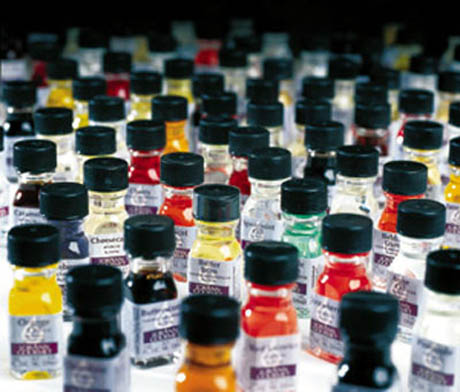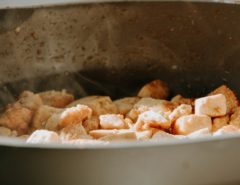I have food anxiety. It isn’t debilitating but I often experience internal battles when I discover new food products. I am not jealous per say, (Aw man, I had that idea last Saturday!) I think I mostly have trouble with patience…
The creativity bar in new food product development is constantly being raised. I understand this is fantastic! But it is also extremely frustrating when you have yet to contribute. Obviously, the industry needs to move product and adapt at a ridiculous pace to maintain relevance. But as a student still in school sometimes I feel left out (I know it’s my choice, but roll with it).

Source giphy.com
Let’s turn our attention to the cracker game. There used to be crackers. Now there are tomato basil crackers, wasabi crackers, gluten free crackers, peanut butter and jelly crackers, rosemary and olive oil crackers, extruded & puffed crackers, black bean and sea salt crackers, savory crackers, sweet crackers…you get the point. So what the heck kind of crackers are we going to get to be a part of developing? I know I am not the only student feeling the burgeoning urge to call each of these company CEO’s ASAP to let them know I HAVE THE NEXT BEST IDEA.

Source giphy.com
HAVE NO FEAR fellow pre-industry celebrities. There might be less opportunity in the cracker aisles (for now), but think of how many other aisles there are… In fact it might serve our future selves well to redistribute our anxious energy towards keeping track of ever-changing trends (while keeping up with school, of course).

Source giphy.com
Let me share some of my most recent trend analyses and then we can get to the best part-the SCIENCE. For example, I’ve noticed that we are not merely drinking value-added beverages anymore. Yes, we can drink a chai latte, but now we can eat a chai latte too! Confused? Just glance around your local marketplace. If you haven’t already noticed, several foods have taken on the flavors of the current beverage craze. To name but a few:
- Cappuccino potato chips
- Caramel macchiato greek yogurt (we can have our coffee and eat it too)
- Chai tea latte popcorn seasoning
- Green tea chocolate
- Earl grey infused chocolate mousse
- Beer bread

Source giphy.com
The reverse is true as well, but perhaps much more familiar. This has been going on for quite a while but new ideas can always be introduced!
- Pumpkin spice latte (may never go out of vogue)
- Hot chocolate (ancient, but relevant)
- Chocolate tea
- Snickerdoodle coffee
- Peanut butter coffee
The lines of food and beverage are blending – what a novel idea! Beverage flavors were for drinking, food for eating, and now who really knows what to expect?
And now for the how! How is it possible that we can generate these seemingly absurd products? Firstly, I believe the trend support has come from the fact that regional food themes are beginning to blend due to the ease of global connections among different cultures. Flavors and ingredients that were typical of one region are appearing elsewhere, and with greater reach than previously possible. For example, Asian influences are reaching the western cultures rapidly and changing our flavor trends. We have wasabi flavored snacks and thai themed products filling up the grocery shelves. But how do we ‘bottle’ these flavors? What makes them reproducible and so reminiscent of the original wasabi or cappuccino?

Blue cheese has many strong aroma compounds. Source igroumet.com
Many flavors can be dissected. That is, flavors can be broken down into their components—think of these as ingredients except on a smaller scale. The other important aspect and perhaps the trickier portion of the recipe is determining the ratios these flavor compounds are present in-which makes a world of difference in the end product. For example, some repulsive compounds in high concentrations would send people out of a room, but canactually be present in many products to simply ‘warm’ up a flavor or add the essence that is undetectable to the average consumer –but that without it wouldn’t be the defined flavor they were looking for. With flavors it’s all about a beautiful balance. This is often the case with many cheeses. There are some off-putting aromas associated with some cheeses, but without them the cheese just would not be right.

Rows and rows of bottle food flavourings which have picked unique compounds from the food.
Often with the help of analytics, and flavorists, scientists can come up with formulas that activate olfactory (smell) and taste receptors in the correct patterns that make flavors associated with the original product be recognizable, but in another matrix! This is how the pumpkin spice latte works, as well as many other outstanding flavored products! There are key components to flavors that help summarize what is intrinsically complex in nature. Inherently strawberry, for example, is incredibly complicated. However, using several key components that are present in high concentrations in nature the strawberry flavor becomes recognizable because our brain can fill in the missing pieces. That’s why strawberry easily crops up in yogurts, ice-cream etc. It is similar to the brain’s mechanism that combats the human eye’s blind spot—it fills in the blanks.
Just when you think all that can be created has been- think again! The world is constantly evolving, the present is becoming the past. The science is always being updated! There is newness every second and creativity does not end! Think deep, innovate and create because your idea might just be the next best thing!






I’m pretty sure food companies have bugged every food science department in the US. I can’t count how many times a PD team has played with an idea and then seen it on the market a 6 months later!